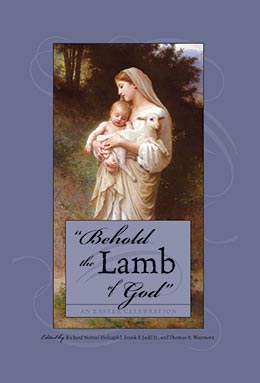Jesus and the Ossuaries: First-Century Jewish Burial Practices and the Lost Tomb of Jesus
Richard Neitzel Holzapfel, Jeffrey R. Chadwick, Frank F. Judd Jr., and Thomas A. Wayment
Richard Neitzel Holzapfel, Jeffrey R. Chadwick, Frank F. Judd Jr., and Thomas A. Wayment, “Jesus and the Ossuaries: First-Century Jewish Burial Practices and the Lost Tomb of Jesus,” in Behold the Lamb of God: An Easter Celebration, ed. Richard Neitzel Holzapfel, Frank F. Judd Jr., and Thomas A. Wayment (Provo, UT: Religious Studies Center, Brigham Young University, 2008), 201–36.
Richard Neitzel Holzapfel was publications director at the Religious Studies Center, Jeffrey R. Chadwick was an associate professor of Church history and doctrine, Frank F. Judd Jr. was an assistant professor of ancient scripture, and Thomas A. Wayment was an associate professor of ancient scripture at Brigham Young University when this was published.
This discussion, “Jesus and the Ossuaries: First-Century Jewish Burial Practices and the Lost Tomb of Jesus,” is an attempt to fulfill Peter’s charge, “Be ready always to give an answer to every man that asketh you a reason of the hope that is in you with meekness and fear” (1 Peter 3:15).
The Easter Season Phenomenon
It seems every Easter that we have some media blitz on the latest controversy regarding Jesus of Nazareth, the New Testament, or the history of early Christianity. In 2005 it was The Da Vinci Code, in 2006 it was the Lost Gospel of Judas; and this Easter season the media drew our attention to The Lost Tomb of Jesus—a program airing on the Discovery Channel followed by release of a companion book, which claimed that the family tomb of Jesus had been found. For many Christians this was an unsettling claim because the program further alleged to have found the ossuary, or bone box, that had held Jesus’s bones—a direct contradiction to the story preserved in the four Gospels that Jesus had indeed risen from the grave.
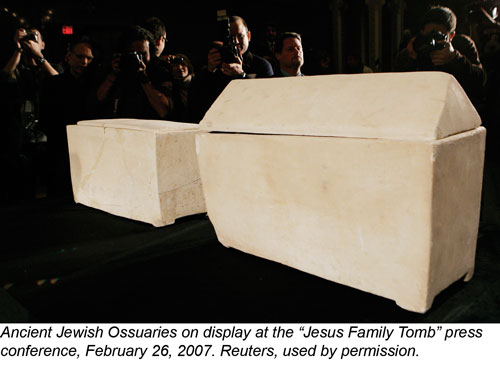
This roundtable discussion will address some of the questions raised by the “Lost Tomb” controversy and will also take advantage of this opportunity to expand our discussion beyond the specifics to the larger first-century Jewish world, which provides a context to our spiritual convictions regarding Jesus’s death, burial, and Resurrection.
Recent Scholarly Advances
We live in a remarkable age of discovery of new data from the past that has forced us to reinterpret past data as competent historians, archaeologists, and biblical scholars make significant progress in reconstructing the world of the New Testament. Many of these men and women are honest, good people dedicated to the pursuit of truth. They include both Jews and Christians. Their work allows us to put Jesus’s ministry in its cultural and historical context in ways that we could not have imagined two or three decades ago. In some ways, we know more about the first century today than we did a hundred years ago.
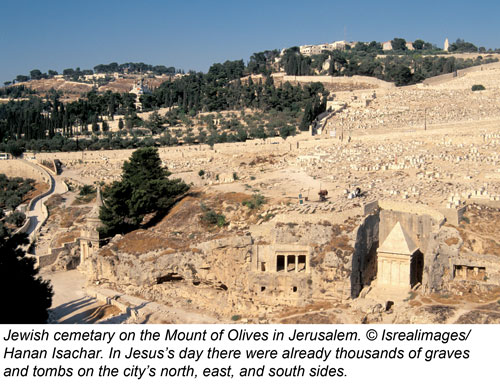
One specific area where significant progress has been made by scholars is the subject of first-century Jewish burial practices. Jewish writings of the period of the New Testament reveal the implicit general belief among Jews that the spirit survives death. Additionally, Jews generally believed that the time of death was determined by God, as Creator. Among the Jews of the first century, some also believed in the literal resurrection of the dead. As a result, Jews believed that the body was to be respected in life and death and that a proper burial was a duty of family members.
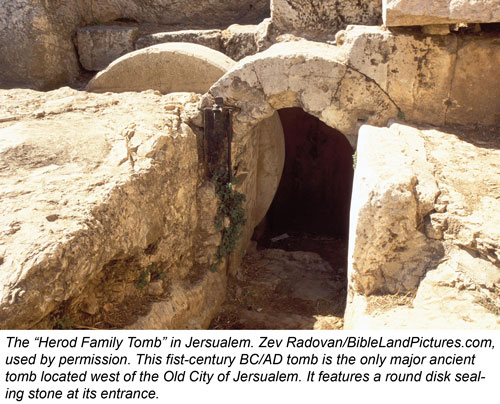
When a person breathed the last breath and the heart stopped beating, the eyes of the deceased were reverentially closed, the entire body was washed and anointed with oil, and the hands and feet were then wrapped in linen bands. The body, clothed in a favorite garment, was then wrapped with winding sheets. Spices of myrrh and aloes were placed in the folds of the garment to perfume the body. A napkin was then bound from the chin to the head. The family took the body on a bier to be buried within hours of death, not days. During the first century, many people were laid to rest in rock-hewn tombs, one of the most prominent features of the hill country of Galilee and Judea; others were buried in the ground.
Burial in a rock-hewn tomb usually consisted of two separate and distinct burials. The first burial was the simple placement of the body in the tomb either in a niche (loculus, Latin for “a little place,” and in Hebrew, kokh, plural kokhim)—shafts cut as deep as a body in the burial chamber—or on an arcosolium—a bench or shelf cut out of the wall of a tomb.
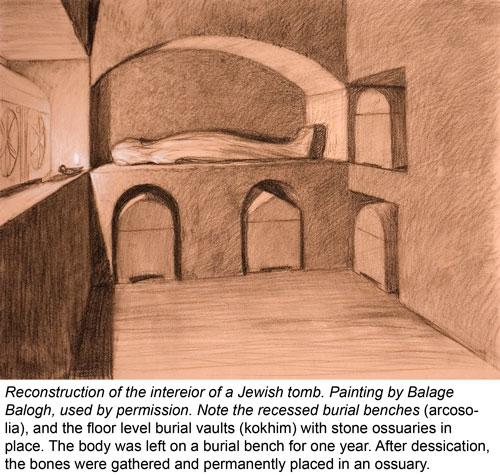
The second burial occurred about a year later when family members reentered the tomb, carefully took the bones of the deceased (once the flesh had completely decomposed), and placed them in a specially prepared, separate container known as an ossuary (from Latin os, “a bone”). These chests were placed in small niches in the tomb for permanent burial. Gathering the bones following the primary burial was considered one of the important duties of a son and was viewed as a time of rejoicing. This practice ended by the middle or end of the third century AD.
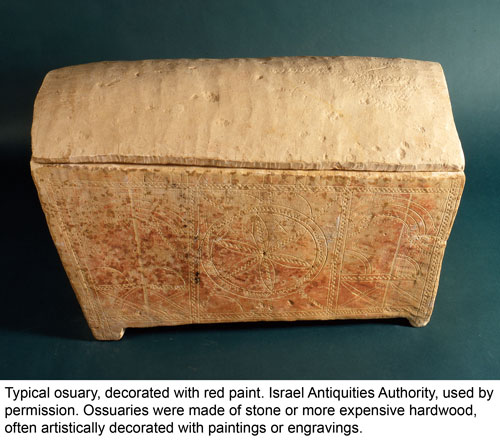
Most of the ossuaries from this period were made of soft limestone, which was common in Jerusalem. A family’s financial means often determined the type of finished ossuary purchased for the deceased. Obviously, those with more means could and did purchase ossuaries with ornamentations, whereas plain ossuaries were no doubt less expensive. Two ossuary “price tags” have been found, suggesting that the cost of an ossuary was within the range of one day’s wage for a common laborer.
A number of ossuary inscriptions that were carelessly executed have been found, including spelling errors and spacing problems. Others have been found with charcoal, ink, and paint inscriptions. It was not uncommon to find inscriptions repeated, sometimes in different languages—including Greek, Hebrew, and Aramaic. In most cases, inscriptions record the name and family relationship of the deceased.
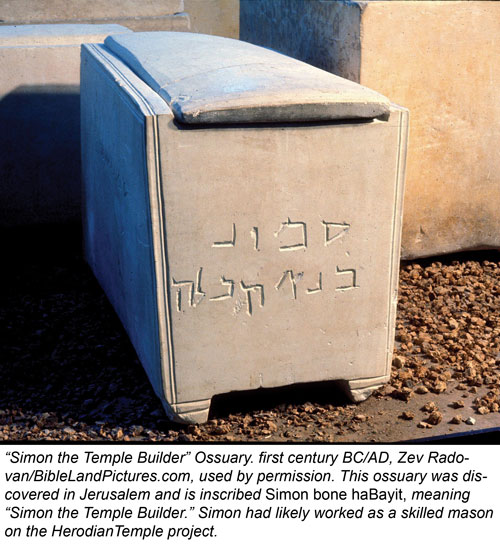
Roundtable Discussion
Holzapfel: What do Matthew, Mark, and Luke tell us about Jesus’s burial?
Judd: The Gospels themselves contain limited information about the burial of Jesus. All four Gospels agree that Joseph of Arimathaea was involved in the burial of Jesus, but each account provides different details. Joseph of Arimathaea was a member of the local governing Jewish council, the Sanhedrin (see Mark 15:43; Luke 23:50), and he did not agree with the council’s decisions concerning Jesus (see Luke 23:50–51). He was a righteous man who had been looking for the kingdom of God (see Mark 15:43; Luke 23:51). By the time of the Crucifixion, Joseph of Arimathaea was secretly a disciple of Jesus (see Matthew 27:57; John 19:38).
After the Crucifixion of the Savior, Joseph of Arimathaea approached Pilate and requested—and was granted—permission to take the body of Jesus for burial (see Matthew 27:58; Mark 15:43; Luke 23:52; John 19:38). Only the Gospel of Mark informs us that Pilate was surprised that Jesus was dead so soon after being placed on the cross (see Mark 15:44). It was possible for a person who was crucified to survive for a few days upon the cross.
The Gospel of John says that Nicodemus assisted Joseph of Arimathaea by bringing spices to prepare the body for burial (see John 19:39–40). Nicodemus was also a member of the Sanhedrin (see John 3:1) and seems, like Joseph of Arimathaea, to have secretly been a disciple of Jesus. He had approached Jesus “by night” (John 3:2) early in the Savior’s ministry (see John 3:1–10) and later had defended Jesus in the council (see John 7:50–51). All four Gospels agree that the body of Jesus was wrapped in a linen shroud and placed in a tomb (see Matthew 27:59–60; Mark 15:46; Luke 23:53; John 19:40–41).
Concerning the tomb itself, each Gospel account supplies important details. Significantly, information from the Gospels preclude the suggestion that the tomb in which Jesus was buried was a family tomb of the Savior. Joseph of Arimathaea, a wealthy man, owned the tomb (see Matthew 27:57, 60). The tomb was new (see Matthew 27:60; John 19:41), and no other body had ever been laid in it before (see Luke 23:53; John 19:41). Further, the tomb was hewn in bedrock (see Matthew 27:60; Mark 15:46; Luke 23:53), and a large stone was rolled to cover the entrance (see Matthew 27:60; Mark 15:46; Luke 24:2; John 20:1). The Gospel of John is the only account to suggest that the tomb was in a garden near the place where Jesus was crucified (see John 19:41).
Holzapfel: What does the Gospel of John say about the burial?
Wayment: The Gospel of John aligns very well with what the synoptic Gospels report about the burial of Jesus, although it adds one simple detail: the site of the burial was very near the place of crucifixion, which would make it possible for Jesus to be buried immediately after being taken down from the cross. This idea seems to play into John’s overall telling of the story. The account from the Gospel of John would not preclude that Jesus’s body would later be placed in an ossuary; although it gives no positive indications that this was intended. I would add that the disciples’ initial misunderstanding of what had taken place to Jesus’s body at the Resurrection provides no indication of whether they intended to eventually place it in an ossuary.
Holzapfel: What do the Gospels say about the Resurrection of Jesus?
Judd: Numerous times during His mortal ministry, the Savior taught His disciples and others that after His death, He would rise again (see, for example, Matthew 16:21; 17:22–23; 20:18–19; 26:32; 27:63; Mark 8:31; 9:9–10; 9:31; 10:34; 14:28; Luke 18:33; 24:6–7; John 2:19). All four Gospels contain ample testimony of the empty tomb. Each account clearly testifies that although the body of Jesus was laid in the tomb, on the third day it was gone. According to the Gospel of Matthew, a guard of Jewish soldiers was placed at the tomb to keep the disciples from stealing the body during the Sabbath (see Matthew 27:62–66). Early on the third day, an angel rolled back the stone (see Matthew 28:1–4). When some of the soldiers informed the chief priests that the tomb was empty, the chief priests bribed the soldiers to tell others that the disciples of Jesus had stolen His body (see Matthew 28:11–15). Then, upon arriving at the tomb, the women disciples entered the tomb and discovered that the body of Jesus was not there, and the heavenly messenger testified that Jesus had risen from the dead (see Matthew 28:1, 5–6; Mark 16:1–6; Luke 24:1–5). In particular, the Gospel of Luke includes the following declaration to the women: “Why seek ye the living among the dead?” (Luke 24:5).
The Gospel of John focuses on the experience of Mary Magdalene. When she saw that the stone had been rolled away from the tomb, she ran and testified of the empty tomb to Peter and John: “They have taken away the Lord out of the sepulchre, and we know not where they have laid him” (John 20:1–2). In response, both Peter and John raced to the tomb and saw for themselves that it was empty (see John 20:3–8).
Each of the Gospel accounts also provides multiple witnesses that Jesus was resurrected with a physical, tangible body. Jesus appeared to Mary Magdalene before any of the other disciples (see Mark 16:9; John 20:16–18). The King James Version translates the words of the Savior to Mary Magdalene as, “Touch me not; for I am not yet ascended to my Father” (John 20:17). This has caused some to suppose that Mary was forbidden to physically touch the resurrected Christ until He reported to His Father in Heaven. The Greek verb, however, that is translated as “touch me not” could be translated as “stop touching me.” The implication is that in her joy at seeing Jesus alive again, Mary Magdalene has grabbed the Savior and is hugging Him. The Joseph Smith Translation may lend support for this understanding in light of the fact that it changes this verse to “Hold me not” (Joseph Smith Translation, John 20:17). Mary Magdalene certainly provides the first eyewitness of Jesus in bodily form, and she may also provide the first sure witness of His physical, resurrected body.
The Gospels provide other witnesses that Jesus was resurrected with a physical body. Soon after His appearance to Mary Magdalene, the resurrected Savior also appeared to the group of women who were returning home from the empty tomb, and they “held him by the feet, and worshipped him” (Matthew 28:9). Later, Jesus appeared to ten of the Apostles (see Luke 24:36–42; John 20:19–23). Because the disciples thought that Jesus was only a spirit, the resurrected Savior responded to them: “Behold my hands and my feet, that it is I myself: handle me, and see; for a spirit hath not flesh and bones, as ye see me have” (Luke 24:39). As further proof of the reality of His physical body, the disciples “gave him a piece of a broiled fish, and of an honeycomb. And he took it, and did eat before them” (Luke 24:42–43). When the Apostle Thomas returned and was told of the appearance of Jesus, he said: “Except I shall see in his hands the print of the nails, and put my finger into the print of the nails, and thrust my hand into his side, I will not believe” (John 20:25). Eight days later, the resurrected Savior appeared again and instructed Thomas, “Reach hither thy finger, and behold my hands; and reach hither thy hand, and thrust it into my side: and be not faithless, but believing” (John 20:27). The Gospels clearly teach that Jesus’s flesh did not rot away and His bones were not collected into an ossuary but that He rose from the dead on the third day with a glorified, physical, resurrected body.
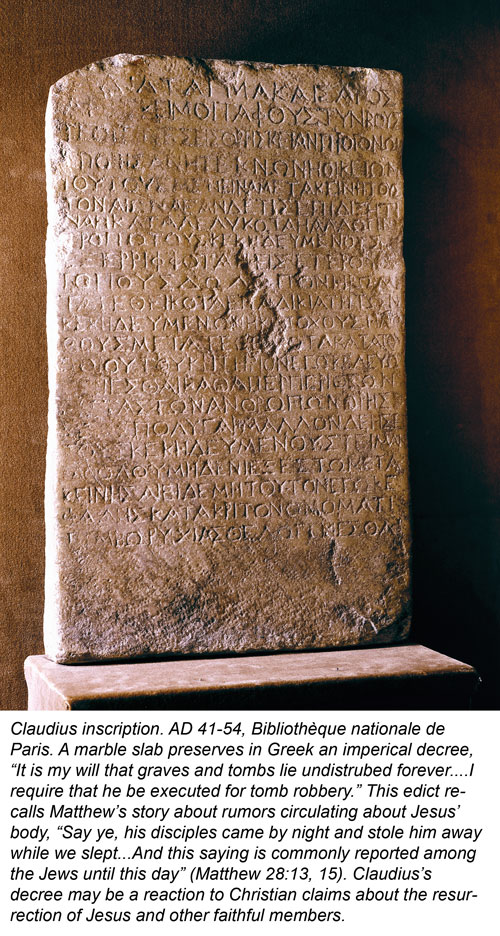
Holzapfel: As Frank noted when the soldiers told the chief priests that the tomb was empty, the Jewish leaders bribed them to say, “His disciples came by night, and stole him away while we slept” (Matthew 28:13). The Gospel of Matthew adds, “And this saying is commonly reported among the Jews until this day” (Matthew 28:11–15). Some scholars suggest that an archaeological discovery, the so-called Claudius inscription, may shed light on this passage.
Wayment: The Claudius inscription is an artifact that came into the possession of the Louvre in 1925, unfortunately without direct provenance. Although the owner, a private collector of antiquities, claimed that he had found it or purchased it in Nazareth. The fact that the artifact cannot be definitively traced to Nazareth is somewhat problematic. However, it records an imperial decree indicating that if any graves are disturbed, the person responsible for doing so would be put to death. Typically this decree is dated between AD 41 and 54; some even suggest that AD 50 is the most accurate date for the stele. It may represent a clumsy attempt by the Roman emperor Claudius to suppress rumors of Jesus’s Resurrection, a topic that was hotly debated between Christians and Jews. If so, it obviously represents a profound misunderstanding of how to stop such rumors.
Holzapfel: What do modern archaeological finds tell us about first-century burial practices?
Chadwick: As was noted before, archaeology in the land of Israel tells us quite a bit about Jewish burial practices in the first century BC and first century AD. Many newly discovered first-century tombs match the description found in the four Gospels. For example, inside a single chamber tomb we typically find three stone benches abutting the stone walls of the cave in a horseshoe or inverted “u” fashion. The entire chamber was essentially a three-sided bench, with a small place in the middle where those who were visiting the tomb or bringing a body in could stand. Variations of this tomb style allowed, in some cases, for entrance chambers where bodies were not buried, connected to one or more adjoining interior chambers with burial benches. Often there were also perpendicular burial vaults carved into the wall on a long axis either at floor level or above the burial bench. Again, these perpendicular burial vaults were called kokhim (a singular vault was called a kokh).
Now what we know about ossuaries is that they were made of carved material, most commonly limestone, and also from imported hard wood. An ossuary cost about a day’s wages, in the case of a simple, undecorated limestone box. But a decorated stone ossuary would cost double that, and a more expensive cedar wood chest could be triple that price. Since wood decays away, archaeologists have found very few remnants of cedar ossuaries. The Jewish sources record that bodies of the deceased were first laid on a burial bench (arcosolium), and there they would decay for about a year or more before a secondary burial would take place. After a year, family members would gather the deceased bones and place them in the smaller chest we call the “ossuary” (the Aramaic-speaking Jews called it gluskema, which is also the Talmud term) for permanent placement in the tomb.
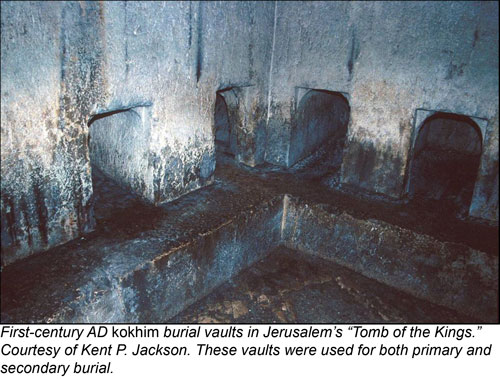
About 750 tombs have been found within a three-kilometer radius of Jerusalem’s Old City on the city’s south, east, and north sides. If you move that radius to five kilometers you come up with about a thousand tombs in that area. Of all these tombs, around one hundred featured burial benches, or the arcosolia. About five hundred tombs feature the low, perpendicular burial vaults called kokhim. All these Jewish tombs, however, were located north, east, or south of the city. Almost no Jewish tombs were located west of the Old City of Jerusalem. This was due to the ancient Jewish belief that wind could carry impurities from decaying bodies over the city. Since the wind blew from the west, burials were forbidden by Jewish law on the west side of the city. With all of these tombs, about several thousand ossuaries have been found to date. Of these only about a thousand are assigned to museums; the rest are in warehouses or privately owned.
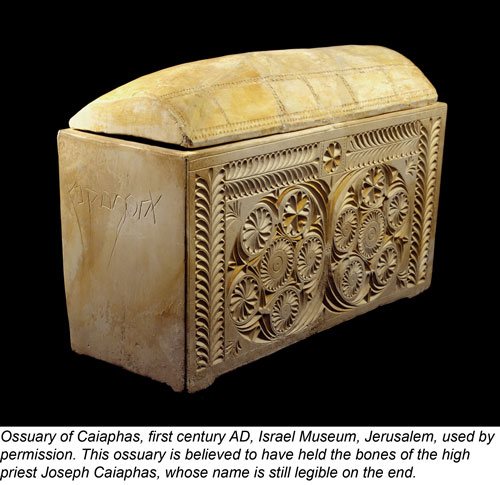
It is difficult to believe that Jesus was buried in a kokh, one of those narrow, perpendicular burial vaults. The Gospel accounts speak of angels sitting at the head and foot of where He had lain, but that scenario would be impossible with a kokh, where one could not sit up at the far end of the vault, nor could even be seen there from an angle outside the tomb. But this also applies to a bench with an arcosolium over it where the arch would be very low at each end of the bench, preventing anyone from sitting up at the head or foot of the burial locus. We can not only conclude that Jesus was not laid in a kokh, but He also cannot have been laid on a recessed arcosolium bench. Thus we can eliminate these features from the picture we create in our mind of what the interior of the tomb of Joseph of Arimathaea looked like, at least in the case of the spot where Jesus was laid in the tomb. We may, however, safely conclude that Jesus was indeed laid on a simple, unrecessed burial bench, since that is not only a prominent feature of Jewish tombs which we know archaeologically, but also is supported by the report of angels sitting at the head and foot of the burial locus after Jesus’s Resurrection. This, too, gives us a fair idea of how to re-create the interior appearance of the Arimathaean’s sepulchre. And since Jesus’s temporary burial there was a primary interment rather than a secondary one, the question of an ossuary being used is not even relevant.

Holzapfel: As noted, archaeologists have found hundreds of first-century tombs and in many cases the contents of those tombs—the ossuaries themselves that provide a flood of information on this period of history. What significant ossuaries have been found to help us appreciate the New Testament better?
Wayment: The Caiaphas ossuary is one of the most impressive ossuaries that has been discovered. It was prepared for Joseph Caiaphas, and if you look carefully you can actually see the name still on the side. The bones found inside the ossuary come from a man who was roughly sixty-five years old. The person to whom this ossuary belonged was also fairly wealthy as evidenced by the elaborate carving and fine detail he was able to afford. Another ossuary is of Nicanor of Alexandria, which is inscribed on the outside of the ossuary. According to Jewish tradition, a Nicanor from Alexandria paid for or worked on the doors of the beautiful gate of the Jerusalem temple.
An ossuary containing the remains of a man named Alexander of Cyrene has also been found. This ossuary is important because it records the name “Alexander the son of Simon.” Mark 15:21 tells us that Simon of Cyrene had a son named Alexander. It is possible that this is the ossuary of Simon of Cyrene’s son as reported in the Gospel of Mark.
Another startling find is the ossuary that contained the bones of a man who had been crucified. The man’s name was John, and in the ossuary they discovered a heel bone that still had a crucifixion spike stuck in it. Apparently the spike had been embedded in the man’s heel, and it was too difficult to remove at his death. The spike forced fragments of olive wood into the man’s heel, which were also still evident when archaeologists discovered the ossuary. It is almost certain that the man was crucified on an olive wood cross during Roman times.
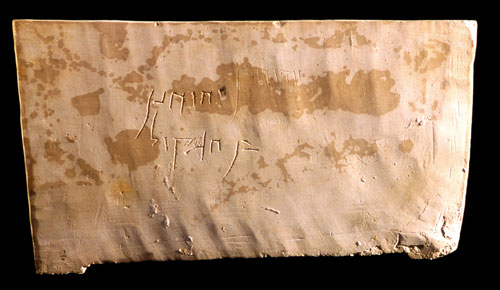
Ossuary of Yohanan ben Hagkol, discovered at Givat HaMivtar in Jerusalem. Israel Museum, used by permission. This first-century AD box contained the bones of a crucified man whose name was inscribed on the ossuary's exterior. 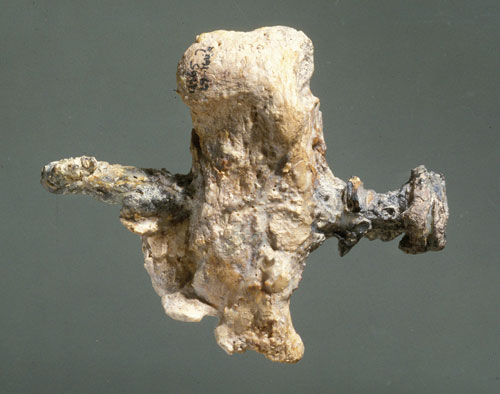 A portion of the victim's fused heel was found with a nail still embedded in the bone, a graphic example of the Roman practice of crucifixion.
A portion of the victim's fused heel was found with a nail still embedded in the bone, a graphic example of the Roman practice of crucifixion.
Holzapfel: The discovery of the crucified man is really important because some scholars had argued that the New Testament story about Jesus’s burial was not plausible since the Romans generally took down crucified victims (slaves and political criminals) themselves and threw the bodies into a mass grave—effectively preventing anyone from memorializing a particular death. This discovery therefore demonstrates that there is at least one example of a crucified victim having been buried in the first century in a personal tomb by family members.
What sites in Jerusalem have been associated with death?
Chadwick: There are two sites that Christians, visiting tourists, and pilgrims hold as having been the site of Jesus’s execution and the tomb of Joseph of Arimathaea.
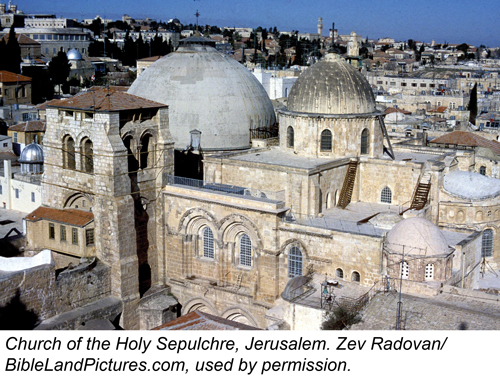
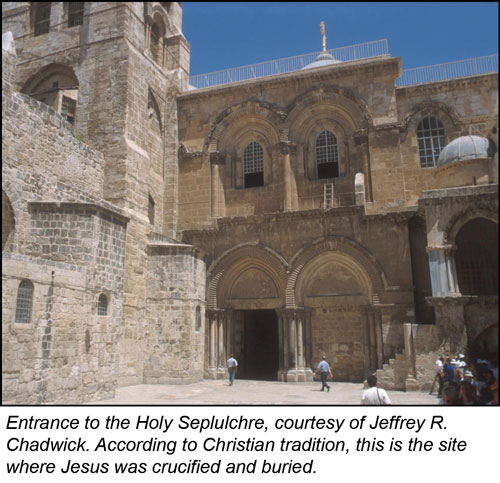
The first one, of course, is the Church of the Holy Sepulchre located in the Christian quarter of Jerusalem’s old city, a place where literally millions and millions of Christian faithful have visited. It will be a very busy place tonight [Easter eve], and in the morning, Easter morning in Jerusalem, when thousands of Orthodox pilgrims will gather inside this remarkable and historic building. The Anastasis, or shrine of the Resurrection of Jesus, is in a great rotunda over the remains of an old second-temple period burial bench from a destroyed tomb. Apparently the Church of the Holy Sepulchre was built in the area of tombs, dating from the centuries before Jesus. Near the Anastasis shrine are two kochim, those low, perpendicular, horizontal burial vaults that go back about two meters and were obviously burial sites. I say these were second-temple period graves, but the second-temple period lasted from the sixth century BC to the first century AD. The problem with the Church of the Holy Sepulchre, from the New Testament perspective, is that it cannot have been an active tomb site in the first century AD when Joseph of Arimathaea constructed his burial cave. Even though it would have been outside the city in the first century, to be sure, it was nevertheless on the west side of the city, an area out of bounds for new tomb construction in the period Jesus lived.
Prior to the reign of Herod the Great there was no northern neighborhood of Jerusalem north of the so-called “first wall.” The tomb that became the Holy Sepulchre Tomb could properly be constructed there, north of the city of Jerusalem, in the second century BC. However, with the reign of Herod the Great a brand new neighborhood grew up in the north of Jerusalem and was surrounded with a wall prior to the birth of Jesus. This means that all the tombs west of that new walled area would have been cleared, the bones redeposited in other places, and no new tombs would have been constructed at the Holy Sepulchre site during the time of Jesus’s life. In other words, the Holy Sepulchre cannot be a site where Joseph of Arimathaea’s tomb would have been constructed.
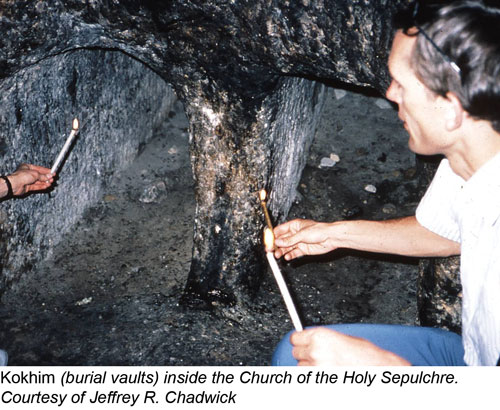
Now we know that the tomb of Joseph was in the place where Jesus was crucified. The very best candidate for Golgotha, or the place of the skull described in the scriptures, is this very skull-like feature on the north side of Jerusalem’s old city. It is often called “Skull Hill” and is near the famous “Garden Tomb,” which is felt by many to be a better candidate for the site where Jesus was laid and rose again.
In terms of placement north of the city, the Garden Tomb does qualify as a site in the place near where Golgotha is likely to have been. The Garden Tomb then, has become a very popular option for Protestant Christians and Latter-day Saints to visit as a candidate of the place of Jesus’s burial. An examination of the tomb shows where burial benches that existed in this tomb when it was originally constructed were later cut away in the Byzantine period.
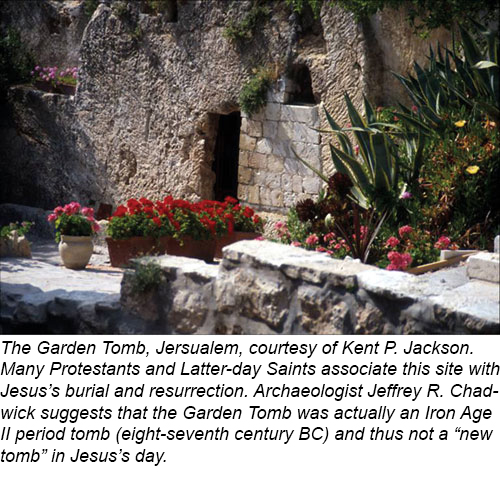
However, the difficulty with the Garden Tomb is that it appears by all stylistic comparisons not to be a second-temple period tomb but rather a seventh—or eighth-century BC tomb, dating hundreds of years before the time of Jesus. This is the conclusion of virtually all archaeologists who deal with ancient Jewish tombs. If that is the case, and my own examination has suggested it probably is, it means that the Garden Tomb, while close to the skull feature, would not have been a new tomb in the first century AD, making it difficult to justify as the tomb of Joseph of Arimathaea.
The good news, however, is that in the area around the skull feature, on its east side, second-temple period tombs were being dug with regularity during the first century AD, and Joseph of Arimathaea’s tomb may indeed have been in that area, very close to the skull feature, as described in the New Testament. It would not have been the Garden Tomb area, which is on the west side of the skull feature, but in the area of Saladin Street, on the east side of the skull feature. Now, the Garden Tomb may still be visited by pilgrims wishing to see a good example of what an ancient tomb looked like and what features would have been present (such as burial benches). You can read my study of Golgotha, the Garden Tomb, and the Holy Sepulchre in The Religious Educator of 2003 if you desire to go into greater detail on these sites. In that article, I note that President Hinckley, on a visit to the Garden Tomb, said that the body of Jesus had been buried either at that site or somewhere nearby. This allows us to consider not only the merits of the Garden Tomb, but also the merits of other sites near the skull feature.
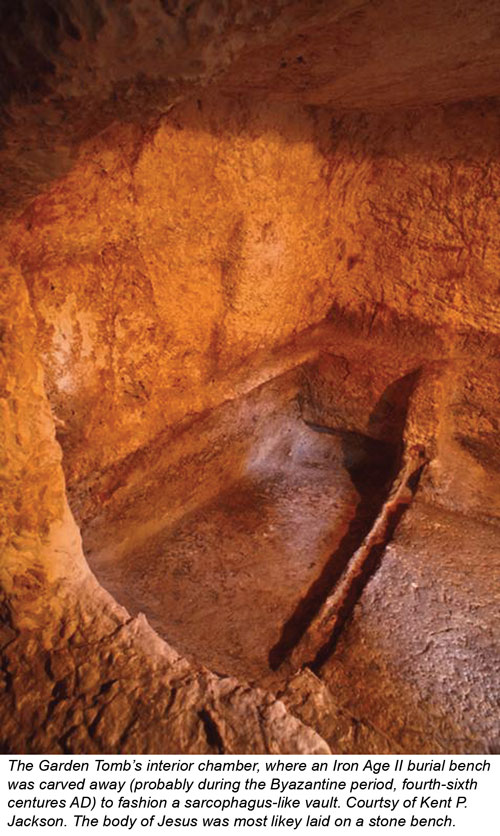
Holzapfel: Having provided an overview of what the scriptures tell us about Jesus’s death, burial, and Resurrection, along with what modern scholars inform us about first-century Jewish burial practices, we can now turn our attention to issues related to the “Lost Tomb of Jesus” controversy:
Lost Tomb of Jesus

Let me briefly outline the story of the Lost Tomb for those who may not have seen the Discovery Channel special, read the recent news reports, or had a chance to skim through the book.
During the past thirty years, hundreds of first-century tombs and thousands of ossuaries have been discovered in and around Jerusalem, or ancient Judea. A rock-hewn tomb, now identified as the Talpiot Tomb, named after the Jerusalem neighborhood where it was accidently discovered in 1980, contained ten ossuaries. Like many other bones boxes of this period, six of them had the names of the deceased inscribed on the lid or sides of the ossuary.
The “Lost Tomb” promoters claim that every inscription found on the six ossuaries are directly tied to individuals mentioned in the Gospel narratives. Further, they argue that the Talpiot Tomb should be identified as Jesus’s family tomb. This is where the story gets interesting. The ossuaries, therefore, are the bone boxes of family members, including Jesus, His wife, and child.
Although there is a veneer of scholarship, as they marshal various types of evidence to substantiate these wild claims, using epigraphers, archaeologists, and statistical studies to prove that the cluster of names could not be happen stance and controversial DNA studies to postulate a relationship between Mary Magdalene and Jesus of Nazareth, many scholars, Jews, Christians, and secular academics, vigorously reject the novel interpretations of the data and claim that in many cases their evidence is flawed.
It should be remembered that the promoters themselves state that the program is part archaeological adventure, part Biblical history, part forensic science, part theological controversy. They state that it is a story that will be carried around the world. In other words, it is another attempt to make money on Jesus. It is now time to get behind the hype to the issues at hand. What are some of the problems associated with this new theory about Jesus’s burial place?
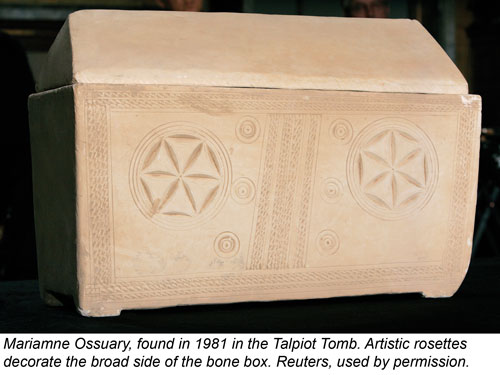
Wayment: The Mary ossuary contains what some recent sensationalist authors have claimed to be the remains of Mary Magdalene. The ossuary is decorated to some degree and therefore likely belonged to a somewhat wealthy individual. The ossuary is not nearly as elaborate as Joseph Caiaphas’s, but nonetheless it has more ornamentation than many other ossuaries. The confusion about this ossuary, and what apparently confused some of the people who initially reported the find, is that two individuals are buried in the same ossuary. This was a fairly common practice, and in fact, many ossuaries contained the remains of several individuals. This ossuary actually contained the remains of a woman named “Mariam” and those of a woman named “Marah.” Through a little confusion of language, someone in the popular media confused the name Marah with the noun for “Master” and thus read the inscription as “Mary a Master.” Unfortunately, the two names are written at very different times in very different writing styles, so there really is no confusion about the names. Therefore, this ossuary is unfortunately not that of Mary Magdalene, but rather of two women named Mary using slightly different spellings of that name. One would expect that if this were the tomb of Mary Magdalene that it would say that, rather than using some obscure title calling her a master. The New Testament does not ever refer to her in that way, and it is a leap of the imagination to associate any other title with Mary other than the woman from Magdala (that is, Magdalene).
Holzapfel: What are the problems with the thesis of the “Lost Tomb”?
Judd: For Latter-day Saint Christians in particular and for other Christians in general, one of the biggest problems with the “Lost Tomb of Jesus” theory is that the authors are attempting to undermine the fundamental doctrine of the empty tomb and the bodily Resurrection of Jesus. As has been plainly demonstrated above, the New Testament is clear that on the third day after His Crucifixion, the tomb of Jesus was empty and Jesus appeared alive, with a physical, resurrected body.
Modern scripture confirms that Jesus was buried after His Crucifixion. The Doctrine and Covenants states that those who come forth in the Resurrection of the just have been “baptized after the manner of his burial, being buried in the water” (D&C 76:51). In the Book of Mormon, Nephi referred to the writings of the prophet Zenos from the brass plates, which contained a prophecy that the Savior would be “buried in a sepulchre” (1 Nephi 19:10). In spite of His immediate burial, modern scripture and modern revelation also confirm that Jesus rose from the dead on the third day with a physical, resurrected body. President Gordon B. Hinckley has testified: “The tomb was sealed, and the guards were set. But no force beneath the heavens could now hold back the power of the Son of God. . . . The Lord of heaven and earth arose from the bier, shook off the burial clothes, and stepped forth to become the firstfruits of them that slept. The empty tomb bore testimony of this greatest of all miracles.”[1]
Latter-day Saints believe in the reality of Jesus’s bodily Resurrection even more strongly than some other Christians. This glorious truth is confirmed most vividly in the Book of Mormon, which contains an extended account of the postmortal visit of the Savior to the Nephites (see 3 Nephi 11–28). When He appeared to a group of two thousand five hundred people (see 3 Nephi 17:25), the resurrected Savior instructed them: “Arise and come forth unto me, that ye may thrust your hands into my side, and also that ye may feel the prints of the nails in my hands and in my feet” (3 Nephi 11:14). The Book of Mormon describes the response in wonderfully specific detail: “The multitude went forth, and thrust their hands into his side, and did feel the prints of the nails in his hands and in his feet; and this they did do, going forth one by one until they had all gone forth, and did see with their eyes and did feel with their hands, and did know of a surety and did bear record, that it was he, of whom it was written by the prophets, that should come” (3 Nephi 11:15).
The body of Jesus was not left in the tomb to rot in order that the bones might be later collected into an ossuary. When somebody died, the most likely scenario would be for a family to make an ossuary or commission an ossuary to be constructed when the flesh had finally rotted away—many months after the death of the individual. Even in the unlikely event that an ossuary for the body of Jesus had been constructed in the small amount of time between His death and the beginning of the Sabbath, it would not have ever been used for the bones of Jesus. On the third day after His death, the tomb of Jesus was empty and the Savior rose from the dead with a glorified physical, resurrected body. Because the death of Jesus occurred a few hours before the Sabbath began and because He rose from the dead early on the third day, there was no time to even make an ossuary or commission one to be made. Since His family and disciples discovered that Jesus was alive again so soon after His death, it is not even likely that an ossuary of Jesus of Nazareth ever existed in the first place.
Chadwick: The problem with the “Lost Tomb” thesis here, from my perspective, is we have found this ossuary with an inscription that has been translated to read “Jesus Son of Joseph.” But more properly the name is actually “Jehoseph,” which has one letter more than the name we translate as “Joseph” from the New Testament. Yeshua, the name that we pronounce as “Jesus,” was a very common name in ancient Judea. So also was Yosef, or “Joseph.” There are also two other forms of the name Joseph—the short form Yosi (spelled “Jose” or “Joses” in our New Testament), and a longer form Yehosef (which would be “Jehoseph” in King James English). Sometimes both Yosef and Yehosef are expressed in English as “Joseph,” but they are actually two very distinct and different names.
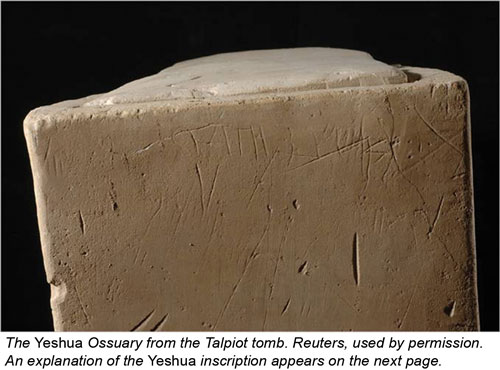
Here is one of the problems I see on this ossuary inscription. I will be very frank in saying that as someone who is experienced in Aramaic, I am not even sure this says Yeshua! That is how L. Y. Rachmani reads it, and Rachmani is a noted scholar, so I will stipulate to that interpretation based on his seniority, but I do not see that this is the best possible reading of that messy name in this messy inscription. That it does say bar (the word for “son”) in the middle, and Yehosef or “Jehoseph” on the end, is clear. The five letter Aramaic name Yehosef is located right there on the ossuary. The problem is that Yehosef (“Jehoseph”) is not the correct spelling for the name of the man who was the guardian father of Jesus. Really, the shorter Hebrew name Yosef (“Joseph”)—without the intermediate “h”—would be the better choice. The reason for this is that it is the shorter Yosef that we find in the Greek texts of the New Testament, rather than longer Yehosef. The man which the New Testament names as Jesus’s guardian was Yosef, not Yehosef. The name on the ossuary is not the New Testament Joseph!
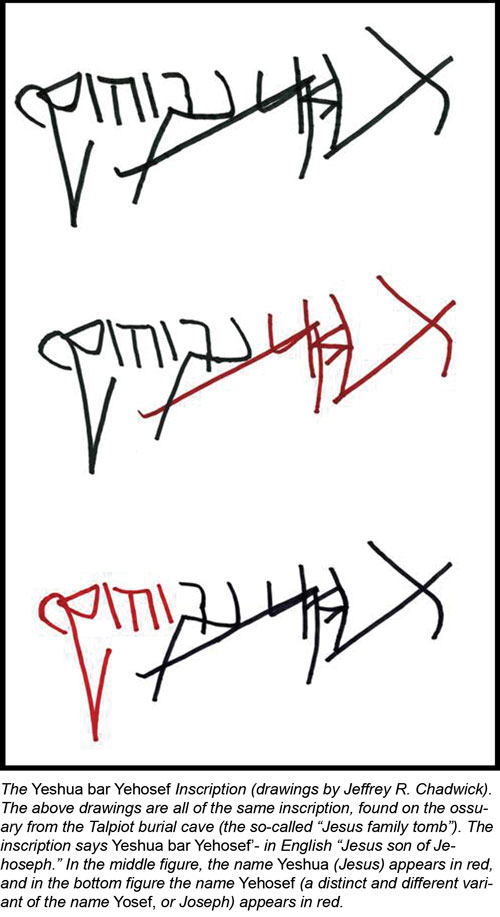
Another inconsistency in the film on the “Lost Tomb of Jesus” is that they also suggest that the so-called “James son of Joseph brother of Jesus” ossuary (a very controversial artifact!) was at one time in the same tomb as well, and that the “James” and the “Jesus” of those inscriptions were sons of the same “Joseph.” But the inscription on that ossuary spells the name Yosef with only four letters, with no intermediate “h,” so the filmmakers have created an internal inconsistency in their own theory—you cannot have your “Joseph” person be called Yosef on one ossuary but Yehosef on another ossuary. The film fails in its logic.
To summarize, while I am sure that the ossuary inscribed with the name Yeshua bar Yehosef was indeed the burial chest of some man called (in our English) “Jesus son of Joseph,” that particular Joseph was not our New Testament hero, Joseph of Nazareth, and that particular Jesus definitely not our New Testament Savior, Jesus of Nazareth.
Conclusion
Holzapfel: When Paul wrote his letter to the Corinthians, apparently some in Corinth believed that there was no bodily Resurrection. Paul was trying to dispel false teachings by drawing the several conclusions he makes in 1 Corinthians 15. First, if the dead do not rise from the grave, then not even Jesus was raised from the dead. Second, Paul’s apostolic preaching of the Resurrection was useless. Third, the Saints’ faith in the Resurrection was also useless. Fourth, the disciples’ witness of the Resurrection was false before God. Fifth, the Corinthian faith was ultimately futile. Sixth, each Saint was still in his or her sins and without hope of redemption. Seventh, the Saints already dead were lost forever. And eighth, the living Saints were, of all men and women living in the Greco-Roman world, most miserable (see 1 Corinthians 15:19). Of the above list the last argument is most consequential for everyone who wishes to become a committed disciple of Jesus. If in this life only we have hope in Christ the mortal, we are of all men most miserable. Paul may mean that if our hope in Christ is based on His life only, then we should be most pitied among all the world’s population for putting up with the heavy cost of discipleship. Yet Paul’s categorical conclusion based on the evidence presented in the first verses of chapter 15 is a straightforward testament: “But now is Christ risen from the dead, and become the firstfruits of them that slept. For since by man came death, by man came also the resurrection of the dead. For as in Adam all die, even so in Christ shall all be made alive” (1 Corinthians 15:20–22). The day will come when we will know of these truths ourselves as found in this passage in 1 Corinthians, for Paul tells us that he knows of the certainty of that Resurrection by his own experience.
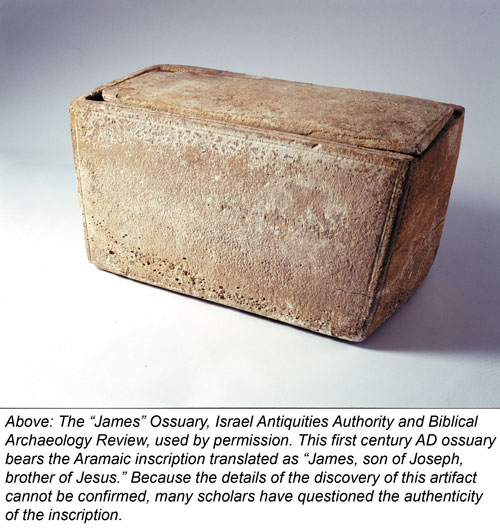
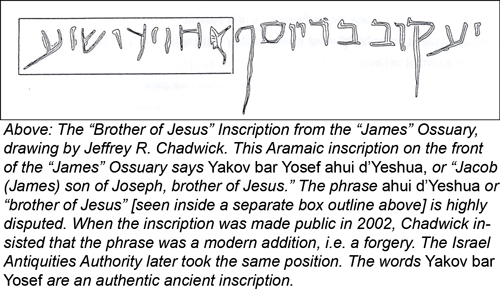
And so next Easter we expect another controversy, but it is all good news. Because every time Jesus makes the cover of Time Magazine or becomes the focus of a national television program, it gives us another opportunity to bear witness, become part of the very public dialogue, and increase our own witness of these important events.
Notes
[1] Gordon B. Hinckley, “The Son of God,” Ensign, December 1992, 4.
